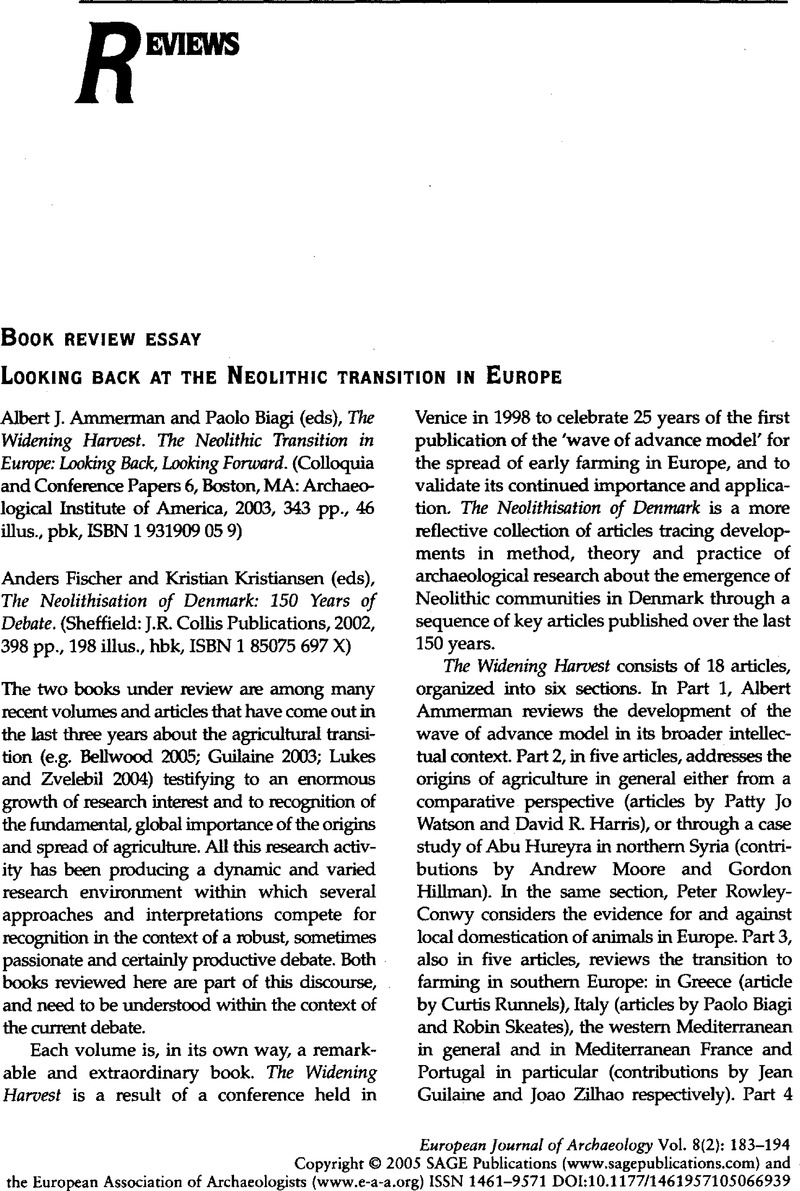No CrossRef data available.
Article contents
Looking back at the Neolithic transition in Europe
Published online by Cambridge University Press: 25 January 2017
Abstract
An abstract is not available for this content so a preview has been provided. Please use the Get access link above for information on how to access this content.

- Type
- Reviews
- Information
- Copyright
- Copyright © 2005 Sage Publications
References
Ammermann, A.J. and Cavalli-Sforza, L.L., 1984. The Neolithic Transition and the Genetics of Populations in Europe. Princeton, NJ: Princeton University Press.Google Scholar
Bellwood, P., 2005. First Farmers. The Origins of Agricultural Societies. Oxford: Blackwell.Google Scholar
Clark, J.G.D.
1965. Radiocarbon dating and the spread of farming economy. Antiquity
31:57–73.Google Scholar
Chikhi, L., Nichols, R.A., Barbujani, G. and Beaumont, M.A., 2002. Y genetic data support the Neolithic demic diffusion model. Proceedings of the National Academy of Sciences of the USA
99:11,008–11,013.Google Scholar
Dennell, R.
1983. European Economic Prehistory: A New Approach. London: Academic Press.Google Scholar
Fix, A.G., 1996. Gene frequency clines in Europe: demic diffusion or natural selection? Journal of the Royal Anthropological Institute
2(4):625–643.CrossRefGoogle Scholar
Gkiasta, M., Russel, T., Shennan, S. and Steele, J.
2003. Neolithic transition in Europe: the radiocarbon record revisited. Antiquity
77:45–62.Google Scholar
Gimbutas, M., Winn, S. and Shimabuku, D.
1989. Achilleion: A Neolithic Settlement in Thessaly, Greece, 6400–5600 BC. Los Angeles: University of California, Institute of Archaeology (Monumenta Archaeologica 14).Google Scholar
Gronenborn, D., 2004. Comparing contact-period archaeologies: the expansion of farming and pastoralist societies to continental temperate Europe and to southern Africa. Before Farming
2003(3) 1–35.Google Scholar
Guilaine, J., 2003. De la vague à la tombe. La conquête Néolithique de la Méditerranée. Paris: Éditions du Seuil.Google Scholar
King, P. and Underhill, P.A., 2002. Congruent distribution of Neolithic painted pottery and ceramic figurines with Y-chromosome lineages. Antiquity
76:707–713.Google Scholar
Lahr, M.M., Foley, R. and Pinhasi, R., 2000. Expected regional patterns of Mesolithic-Neolithic human population admixture in Europe based on archaeological evidence. In Renfrew, C. and Boyle, K. (eds), Archaeogenetics: DNA and the Population Prehistory of Europe,
81–88. Cambridge: McDonald Institute for Archaeological Research.Google Scholar
Lukes, A. and Zvelebil, M. (eds), 2004. LBK Dialogues: Studies in the Formation of the Linear Pottery Culture. Oxford: Archaeopress, BAR International Series 1304.Google Scholar
Neustupný, E., 2004. Remarks on the origin of the Linear Pottery Culture. In Lukes, A. and Zvelebil, M. (eds), LBK Dialogues: Studies in the Formation of the Linear Pottery Culture:
3–5. Oxford: Archaeopress, BAR International Series 1304.Google Scholar
Richards, M. and Macaulay, V., 2000. Genetic data and the colonization of Europe: genealogies and founders. In Renfrew, C. and Boyle, K. (eds), Archaeogenetics: DNA and the Population Prehistory of Europe:
139–151. Cambridge: McDonald Institute for Archaeological Research.Google Scholar
Rowley-Conwy, R, 1996. Why didn't Westropp's Mesolithic catch on in 1872?
Antiquity
70:940–944.CrossRefGoogle Scholar
Zvelebil, M.
1986. Mesolithic societies and the transition to farming: problems of time, scale and organisation. In Zvelebil, M. (ed.), Hunters in Transition:
167–188. Cambridge: Cambridge University Press.Google Scholar
Zvelebil, M.
1998
Genetic and cultural diversity of Europe. A comment on Cavalli-Sforza. Journal of Anthropological Research
54(3):411–416.CrossRefGoogle Scholar
Zvelebil, M., 2000. The social context of the agricultural transition in Europe. In Renfrew, C. and Boyle, K. (eds), Archaeogenetics: DNA and the Population Prehistory of Europe:
57–79. Cambridge: McDonald Institute for Archaeological Research.Google Scholar


